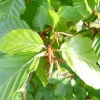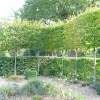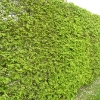Features
This deciduous tree has a distinctive, fluted trunk with silvery-grey bark. Green catkins appear in spring, developing into the autumnal winged fruits (samara) which hang in clusters. The leaves are deeply veined (they almost look folded), doubly toothed along their edges and light green in spring. They become darker green before yellowing attractively in autumn, being retained into winter on younger trees.
What to use it for
A tall tree which would make a good focal point in a larger garden and is low maintenance. Can be pollarded or pleached and grown as a hedge. It’s often used to line wide boulevards, in parkland or in woodlands. A good wildlife choice as birds can nest in it and some eat its seeds. The leaves are also a food source for some moth larvae.
How to look after it
This is a low maintenance plant and requires little looking after, except for the training and pruning outlined below.
How to prune it
Carpinus betulus should be pruned from late summer to mid winter, avoiding the main seasons of growth when the tree may bleed sap profusely and be weakened as a result.
If you are growing it as a tree it may be trained either as a feathered tree or a central leader standard. Once established little pruning is required.
To grow it as a hedge the plants should be pruned lightly when planted. After that, weaker growth should be pruned hard (cut back by about two-thirds) and strong shoots pruned lightly (reduce the length by about a third), to encourage even growth (harder pruning will lead to more vigorous growth).
Pleaching should be done with three or four year old plants, tying them into a strong framework. Prune them upon planting and continue to prune and train them into the framework annually.
Hornbeams will tolerate hard pruning, however this will result in lots of twiggy growth. This is fine if you’re growing a hedge, but if you have a tree and hard prune the trunk or a main branch then you will need to thin out the resulting growth the following year to retain just a few, strong shoots.
How to propagate it
Collect seeds and sow them outdoors in autumn (if you leave them on the tree into the winter they will become dormant, forming a hard seed coat, and may not germinate for two to three years). Alternatively, take greenwood cuttings in early summer or graft (whip-graft) in winter.
Common problems
Hazelnut powdery mildew and coral spot can affect hornbeams. The leaves and young shoots may be damaged by aphids, caterpillars or leafhoppers. Witches’ brooms can also affect Carpinus betulus.
Other useful information
The common name ‘hornbeam’ derives from the Old English ‘beam’ meaning tree (originating from ‘baum’, the German for tree) and ‘horn’ relates to the fact that the wood was seen to be as hard as horn. The hardness of the wood meant that it was traditionally used to make butcher’s blocks, skittles and gun butts.
This plant has been given the Award of Garden Merit by the RHS.








